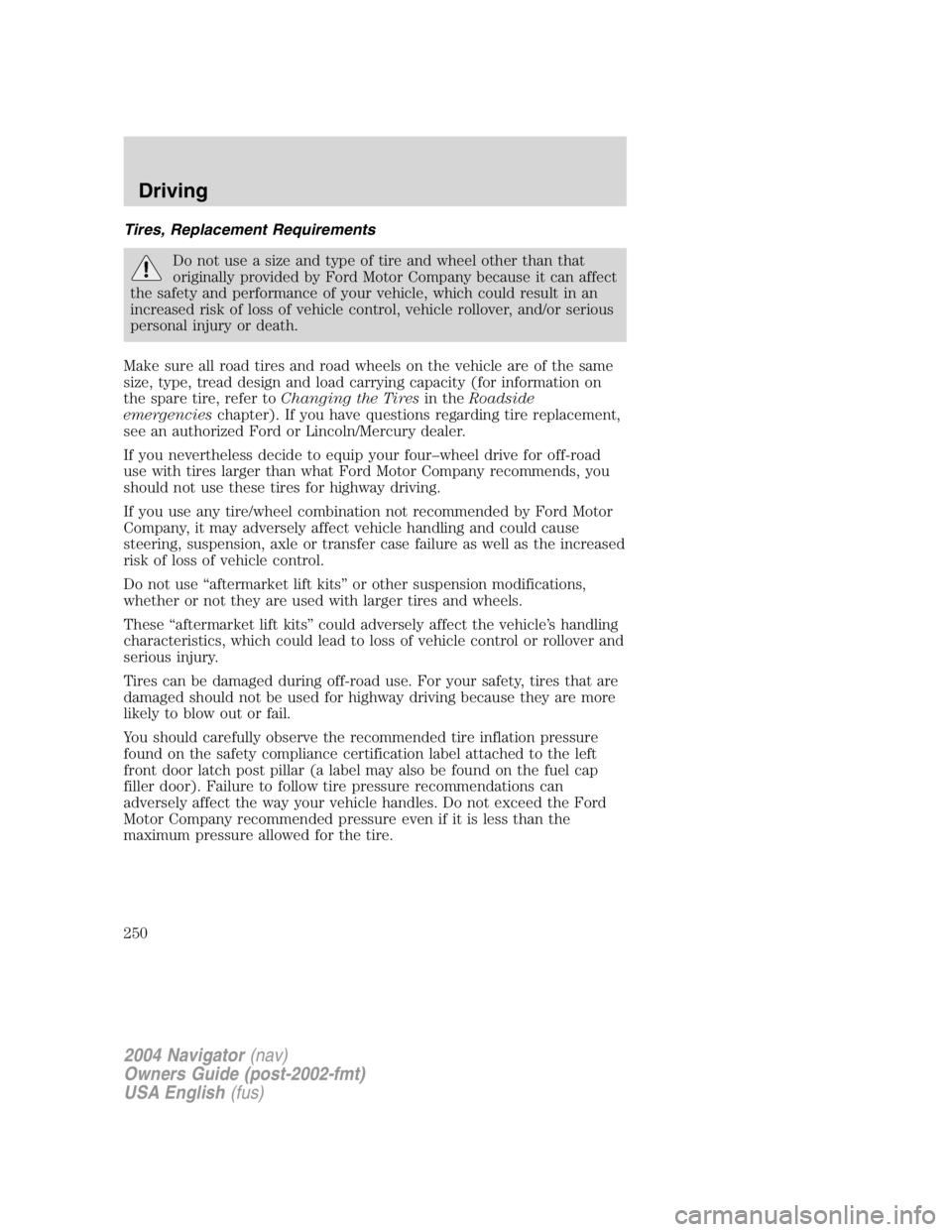load capacity LINCOLN NAVIGATOR 2004 Owners Manual
[x] Cancel search | Manufacturer: LINCOLN, Model Year: 2004, Model line: NAVIGATOR, Model: LINCOLN NAVIGATOR 2004Pages: 368, PDF Size: 8.21 MB
Page 250 of 368

Tires, Replacement Requirements
Do not use a size and type of tire and wheel other than that
originally provided by Ford Motor Company because it can affect
the safety and performance of your vehicle, which could result in an
increased risk of loss of vehicle control, vehicle rollover, and/or serious
personal injury or death.
Make sure all road tires and road wheels on the vehicle are of the same
size, type, tread design and load carrying capacity (for information on
the spare tire, refer to Changing the Tires in the Roadside
emergencies chapter). If you have questions regarding tire replacement,
see an authorized Ford or Lincoln/Mercury dealer.
If you nevertheless decide to equip your four – wheel drive for off-road
use with tires larger than what Ford Motor Company recommends, you
should not use these tires for highway driving.
If you use any tire/wheel combination not recommended by Ford Motor
Company, it may adversely affect vehicle handling and could cause
steering, suspension, axle or transfer case failure as well as the increased
risk of loss of vehicle control.
Do not use “ aftermarket lift kits ” or other suspension modifications,
whether or not they are used with larger tires and wheels.
These “ aftermarket lift kits ” could adversely affect the vehicle ’ s handling
characteristics, which could lead to loss of vehicle control or rollover and
serious injury.
Tires can be damaged during off-road use. For your safety, tires that are
damaged should not be used for highway driving because they are more
likely to blow out or fail.
You should carefully observe the recommended tire inflation pressure
found on the safety compliance certification label attached to the left
front door latch post pillar (a label may also be found on the fuel cap
filler door). Failure to follow tire pressure recommendations can
adversely affect the way your vehicle handles. Do not exceed the Ford
Motor Company recommended pressure even if it is less than the
maximum pressure allowed for the tire.
2004 Navigator (nav)
Owners Guide (post-2002-fmt)
USA English (fus)Driving
250
Page 252 of 368

If driving through deep or standing water is unavoidable, proceed very
slowly. Never drive through water that is higher than the bottom of the
hubs (for trucks) or the bottom of the wheel rims (for cars).
Once through the water, always try the brakes. Wet brakes do not stop
the vehicle as effectively as dry brakes. Drying can be improved by
moving your vehicle slowly while applying light pressure on the brake
pedal.
Driving through deep water where the transmission vent tube is
submerged may allow water into the transmission and cause
internal transmission damage. Have the fluid checked and, if
water is found, replace the fluid.
VEHICLE LOADING
Before loading a vehicle, familiarize yourself with the following terms:
• Base Curb Weight: Weight of the vehicle including any standard
equipment, fluids, lubricants, etc. It does not include occupants or
aftermarket equipment.
• Payload: Combined maximum allowable weight of cargo, occupants
and optional equipment. The payload equals the gross vehicle weight
rating minus base curb weight.
• GVW (Gross Vehicle Weight): Base curb weight plus payload
weight. The GVW is not a limit or a specification.
• GVWR (Gross Vehicle Weight Rating): Maximum permissible total
weight of the base vehicle, occupants, optional equipment and cargo.
The GVWR is specific to each vehicle and is listed on the Safety
Certification Label on the driver ’ s door pillar.
• GAWR (Gross Axle Weight Rating): Carrying capacity for each axle
system. The GAWR is specific to each vehicle and is listed on the
Safety Certification Label on the driver ’ s door pillar.
• GCW (Gross Combined Weight): The combined weight of the
towing vehicle (including occupants and cargo) and the loaded trailer.
• GCWR (Gross Combined Weight Rating): Maximum permissible
combined weight of towing vehicle (including occupants and cargo)
and the loaded trailer
• Maximum Trailer Weight Rating: Maximum weight of a trailer the
vehicle is permitted to tow. The maximum trailer weight rating is
determined by subtracting the vehicle curb weight for each
engine/transmission combination, any required option weight for trailer
towing and the weight of the driver from the GCWR for the towing
vehicle.
2004 Navigator (nav)
Owners Guide (post-2002-fmt)
USA English (fus)Driving
252
Page 253 of 368

• Maximum Trailer Weight: Maximum weight of a trailer the loaded
vehicle (including occupants and cargo) is permitted to tow. It is
determined by subtracting the weight of the loaded trailer towing
vehicle from the GCWR for the towing vehicle.
• Trailer Weight Range: Specified weight range that the trailer must
fall within that ranges from zero to the maximum trailer weight rating.
Remember to figure in the tongue load of your loaded trailer when
figuring the total weight.
Do not exceed the GVWR or the GAWR specified on the
certification label.
Do not use replacement tires with lower load carrying capacities than the
originals because they may lower the vehicle ’ s GVWR and GAWR
limitations. Replacement tires with a higher limit than the originals do
not increase the GVWR and GAWR limitations.
The Safety Certification Label, found on the driver ’ s door pillar, lists
several important vehicle weight rating limitations. Before adding any
additional equipment, refer to these limitations. If you are adding weight
to the front of your vehicle, (potentially including weight added to the
cab), the weight added should not exceed the front axle reserve capacity
(FARC). Additional frontal weight may be added to the front axle reserve
capacity provided you limit your payload in other ways (i.e. restrict the
number of occupants or amount of cargo carried).
Always ensure that the weight of occupants, cargo and equipment being
carried is within the weight limitations that have been established for
your vehicle including both gross vehicle weight and front and rear gross
axle weight rating limits. Under no circumstance should these limitations
be exceeded.
Exceeding any vehicle weight rating limitation could result in
serious damage to the vehicle, loss of vehicle control, vehicle
rollover, and/or personal injury.
Special loading instructions for owners of pickup trucks and
utility-type vehicles
For important information regarding safe operation of this type
of vehicle, see the Preparing to drive your vehicle section in
this chapter.
2004 Navigator (nav)
Owners Guide (post-2002-fmt)
USA English (fus) Driving
253
Page 317 of 368

Coolant refill capacity
To find out how much fluid your vehicle ’ s cooling system can hold, refer
to Refill capacities in this chapter.
Fill your engine coolant reservoir as outlined in Adding engine coolant
in this chapter.
Severe climates
If you drive in extremely cold climates (less than – 36 ° C[ – 34 ° F]):
• It may be necessary to increase the coolant concentration
above 50%.
• NEVER increase the coolant concentration above 60%.
• Increased engine coolant concentrations above 60% will
decrease the overheat protection characteristics of the engine
coolant and may cause engine damage.
• Refer to the chart on the coolant container to ensure the
coolant concentration in your vehicle will provide adequate
freeze protection at the temperatures in which you drive in the
winter months.
If you drive in extremely hot climates:
• It is still necessary to maintain the coolant concentration
above 40%.
• NEVER decrease the coolant concentration below 40%.
• Decreased engine coolant concentrations below 40% will
decrease the corrosion protection characteristics of the engine
coolant and may cause engine damage.
• Decreased engine coolant concentrations below 40% will
decrease the freeze protection characteristics of the engine
coolant and may cause engine damage.
• Refer to the chart on the coolant container to ensure the
coolant concentration in your vehicle will provide adequate
protection at the temperatures in which you drive.
Vehicles driven year-round in non-extreme climates should use a 50/50
mixture of engine coolant and distilled water for optimum cooling system
and engine protection.
What you should know about fail-safe cooling
If the engine coolant supply is depleted, this feature allows the vehicle to
be driven temporarily before incremental component damage is incurred.
The “ fail-safe ” distance depends on ambient temperatures, vehicle load
and terrain.
2004 Navigator (nav)
Owners Guide (post-2002-fmt)
USA English (fus) Maintenance and Specifications
317
Page 363 of 368

change oil soon warning,
message center .......................308
checking and adding ..............308
dipstick ....................................308
filter, specifications ........310, 348
recommendations ...................310
refill capacities ........................349
specifications ..................351, 354
Exhaust fumes ..........................220
Extended Rear Park Assist ......238
F
Fail safe cooling ........................317
Floor mats .................................149
Fluid capacities .........................349
Foglamps .....................................99
Four-Wheel Drive vehicles .......240
control trac .............................240
description ..............................241
driving off road .......................243
electronic shift ........................242
indicator light .........................240
preparing to drive your
vehicle .....................................227
Fuel ............................................319
calculating fuel
economy ..........................139, 323
cap ...........................................321
capacity ...................................349
choosing the right fuel ...........321
comparisons with EPA fuel
economy estimates .................326
detergent in fuel .....................322
filling your vehicle with
fuel ...........................319, 321, 323
filter, specifications ........323, 348
fuel pump shut-off switch .....263
improving fuel economy ........323
octane rating ...................322, 354 quality ......................................322
running out of fuel .................322
safety information relating to
automotive fuels .....................319
Fuses ..................................265 – 266
G
Garage Door Opener (see
Homelink wireless control
system) ......................................132
Gas cap (see Fuel cap) ............321
Gas mileage (see Fuel
economy) ...................................323
Gauges .........................................14
GAWR (Gross Axle Weight
Rating) .......................................252
calculating ...............................254
definition .................................252
driving with a heavy load ......252
location ....................................252
GVWR (Gross Vehicle Weight
Rating) .......................................252
calculating .......................252, 254
definition .................................252
driving with a heavy load ......252
location ....................................252
H
Hazard flashers .........................263
Headlamps ...................................99
aiming ......................................101
autolamp system .......................99
bulb specifications ..................103
daytime running lights ...........100
flash to pass ............................100
high beam ...............................100
replacing bulbs .......................105
turning on and off ....................99
2004 Navigator (nav)
Owners Guide (post-2002-fmt)
USA English (fus) Index
363